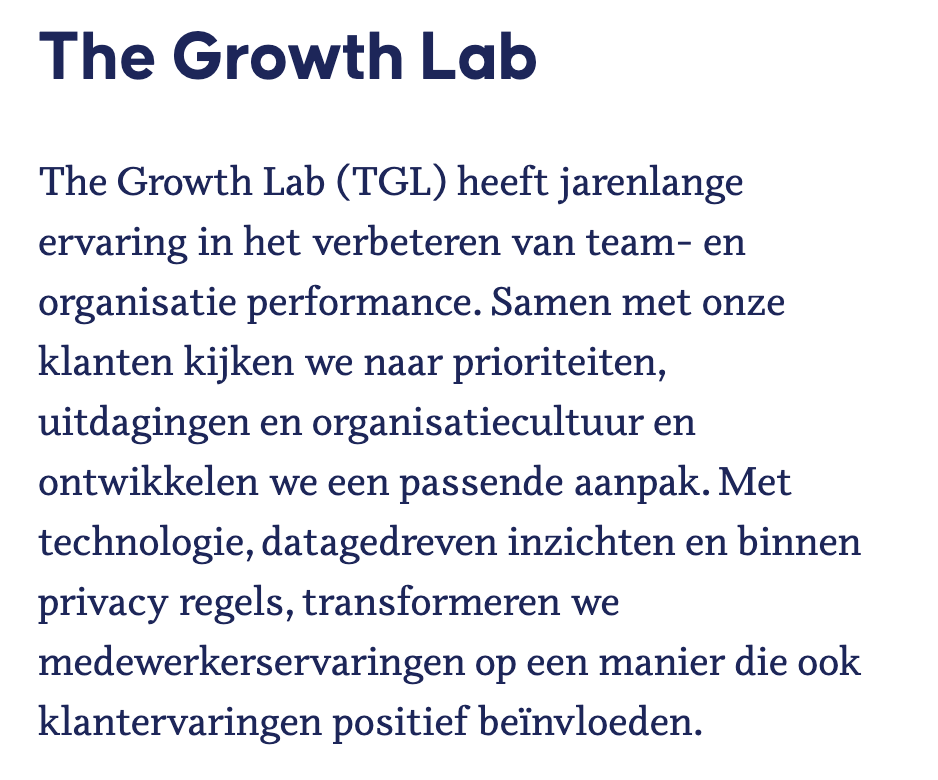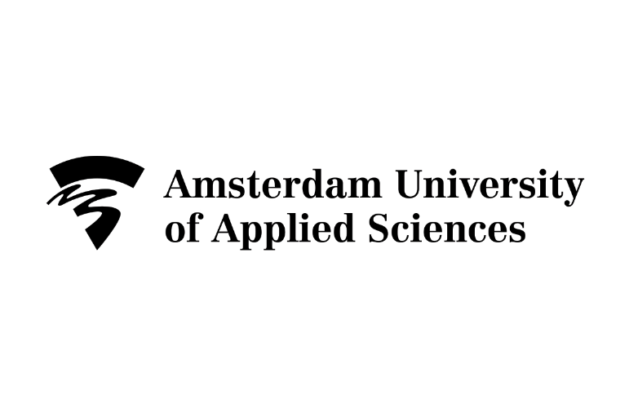The advisors of The Growth Lab (TGL) have years of experience in improving team and organizational performance. With data-driven and people-oriented insights, they transform employee experiences in a way that also positively influences customer experiences. Particularly with strategic change tasks, it is important to involve employees as much as possible in the change. They use various methods for this. Increasing the well-being and involvement of employees is leading in their projects, says Bas van ‘t Eind, partner of The Growth Lab. Van ’t Eind: “Happier people deliver better services and successful changes. How do you keep employees happy? We investigate under what circumstances people work, how they work and we actively involve employees in change processes as much as possible. We focus on employee satisfaction. If they are happy in their job and do not become overburdened, it will have a direct effect on the primary goal of the change project. And that works out well for everyone.”
Request demo
Measurable, collective opinion formation with 600 teachers
The Faculty of Digital Media and Creative Industry of the Amsterdam University of Applied Sciences has asked The Growth Lab to (re)assess the workload for teachers. To this end, calculation models are set up about, among other things, the workload. However, it is difficult to measure the extent to which these correspond with practice. The board and participation council of the university of applied sciences (sub-council) wanted to investigate this together with the more than 600 lecturers in permanent employment. They then enlisted the help of The Growth Lab. Van ’t Eind: “In the past, the board and the district council consulted together to arrive at the new calculation model that indicates the task load. Then it was implemented in the organization. But because so much has changed at the same time in the forms of education, the roles of teachers, the organization and teamwork, a new approach is needed.
Actively involve supporters
We have advised to exclude the bias of each person, and to avoid decision-making being determined by a small group, of which you do not know whether they represent the entire group. We advised that the entire constituency be involved in thinking about the issue together. In other words, active involvement of the collective, which is what The Growth Lab stands for. Teachers – just like any employee – certainly need to express their opinions. The challenge is, you don’t get that many lecturers together in a room, if that is even feasible from an organizational point of view. And a video meeting with more than 10 people is already quite a challenge. Often in plenary, inhouse meetings, the most vocal attendees predominate and there is little time and space to collect good ideas and to really have time to listen and to reflect. An average survey form is also too limited: you don’t get the deeper, qualitative layering from the open answers and the validation of the results is missing. After all, something that is mentioned the most does not mean that it has the most value according to the group. Participants have not listened to each other’s answers, so you don’t yet know what they think of the answers of others: better or less good than their own? In addition, we also notice a survey fatigue among employees in general and a need for dialogue. At The Growth Lab we use different working methods and we have now used CircleLytics’ online, asynchronous dialogue twice at this faculty. The most supported contributions, those that receive the most support from others, determine the result. But also the contributions that are most rejected by the rest provide indispensable data for smart analysis and decision-making.”
Frank Kresin, dean of the faculty: “Turner and The Growth Lab have broken through an impasse that had arisen in recent years. We are pleased that with their help we have found a supported solution for the complex problem of task load.”
Successful online dialogues
The CircleLytics Dialogue consists of two rounds. In the first round, a number of questions are asked. Participants answer these (mostly open) questions. In the second round, participants are invited to rate the answers of their colleagues. They each get to see different answers from others, which are also as different as possible. This really increases the diversity of the dialogue and everyone’s thinking. After this, it is immediately clear which proposals or ideas are warm to the heart of the majority of employees and which are not. This anonymous dialogue can be completed at any time during a number of set days. Van ’t Eind: “The board and district council initiated this dialogue. We used the dialogue to identify the requirements that the new system for determining the workload had to meet. In this working method, employees are really given the space to share what they think of something, they learn how others think about it and they are therefore allowed to think about it again and make choices. The outcome of the dialogues was a success: 200 teachers contributed to answering these questions and collectively gave thousands of appreciations to the answers of others. That is a response of 33%, which is unprecedented for an online tool at this organization.”
Ask the right questions
Van ‘t Eind continues: “Most of the work is in preparing for the dialogue. Asking the right questions will provide answers that you can move forward with. In order to arrive at the right questions, we held various design discussions with stakeholders. This is how we came up with four open questions for the first dialogue.
It immediately became clear that some terms used are not known to everyone and we were able to respond to this. Participation in the second round shows that teachers like to join the discussion and build on the ideas and opinions of others. Ultimately, this makes the answers more complete and specific. Exactly the intention of the dialogue on this issue.
In the second dialogue we presented proposals for improvement to the teachers. The reactions help us enormously to fine-tune the design to what is important to the teachers. ”
Also read what other organizations in education achieve with CircleLytics Dialogue, such as Salta Group: “Participants have a few days, so you do not have the rush of a focus group, but you do have the proverbial night’s sleep, which is necessary for reflection. That reflection on our questions and reflection on each other’s (other) answers (and scoring up/down) guarantee in-depth and validation. They are also allowed to change their closed scale if they wish and a high percentage do so. Unlike surveys, you therefore get high reliability .” Read more here.
Learn from each other’s differing answers
As expected, the answers were mixed by AI. However, because the participants in the second round could judge the answers given, The Growth Lab got insights into which answers received the most support or least support, and why. Van ’t Eind: “Only because of that validation process, can I interpret the answers properly, not because a word is mentioned a lot. The second round makes this dialogue a guideline for coming up with supported advice and you also learn from people what they reject and why. The open questions also gave us answers that we would never have wanted or dared to ask for in closed questions. We also got some very good ideas from these dialogues.
Structured, people-centered working method 
My biggest concern with the project was not so much the content, but much more how we could achieve a supported result. No one likes fake democracy. It will work against you later on and will lead to resistance and loss of involvement. This has been prevented with the use of dialogue. The evidence is on the table. These are reliable, data-driven results that you can back up. Our client sees the added value of solving complex problems together in a fast, structured way. However, it is always important to determine the timing of the dialogue in the process, and how you design the questions. The dialogue is easily scalable and can also be used for very large populations or in smaller parallel sessions to run multiple asynchronous workshops for example. This working method is an enrichment of our toolset. We have now used the dialogue fairly early in the decision-making process, but you can also use this working method to monitor and make adjustments during the implementation phase.”
Creating reliable support
The client is very pleased with the use of the online dialogue. Gerald Stap, chairman of the faculty’s sub-council: “Thanks to the contribution of The Growth Lab and Turner, we as a sub-council gained a better insight into what our lecturers think of this complicated issue. Questioning the teachers was important to the project in order to identify the question behind the question and thus address the actual problem rather than just the symptoms. This made it possible to convince management and steering group of possible and feasible scenarios. (You can listen to a podcast about the project here.)
Because the lecturers are involved in this process (both during the questioning and the elaboration in working groups), this helps to create support for approval from the participational body.”
To learn more about The Growth Lab, one of CircleLytics Dialogue’s partners, click here. If you would like to speak with CircleLytics further and see a demo, click here and schedule your appointment.


